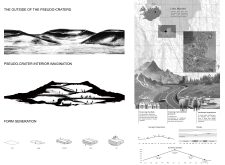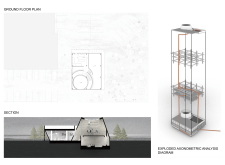5 key facts about this project
### Project Overview
The redesign of Ber Spa Hotel is situated in the Lake Mývatn region of Iceland, where the unique geological formation of pseudo-craters serves as a significant contextual influence. The intent of this project is to replace the existing facility with a comprehensive hub that facilitates relaxation, brewing, and social interaction, while harmonizing with the surrounding landscape.
### Spatial Configuration and Flow
A tiered structure has been implemented to reflect the natural contours of the pseudo-craters, creating distinct areas for various functions. The upper level accommodates a café, a brewing area, and a terrace that provides expansive views, fostering social engagement. The ground floor contains a souvenir shop and brewery to promote local commerce, while the lower level is dedicated to spa experiences, featuring unique beer bath areas and relaxation lounges.
Circulation within the hotel is enhanced through the integration of dual staircases, with one external for access to the upper levels and another internal for movement between spa areas. This design promotes fluid movement and transition between indoor and outdoor spaces, facilitating a cohesive user experience. The large glass façades throughout the building enhance visual connectivity with the external landscape, immersing guests in the natural beauty of the region.
### Materiality and Sustainability
Attention to material selection plays a crucial role in the project's sustainability and aesthetic cohesion. Concrete serves as the primary structural material, providing durability, while extensive use of glass optimizes natural light and offers unobstructed views of the scenic surroundings. Wood accents in flooring and interiors reflect local craftsmanship, adding warmth to the environment. Natural stone is employed in spa areas and cladding, reinforcing the connection between interior and exterior spaces.
The design also prioritizes environmental sustainability by considering local climatic conditions and incorporating passive design strategies. Energy-efficient features such as natural lighting and strategic heating contribute to the overarching commitment to ecological responsibility. The landscaping is designed to include native flora and fauna, promoting ecological continuity and enriching guests' connection to the local environment.






















































